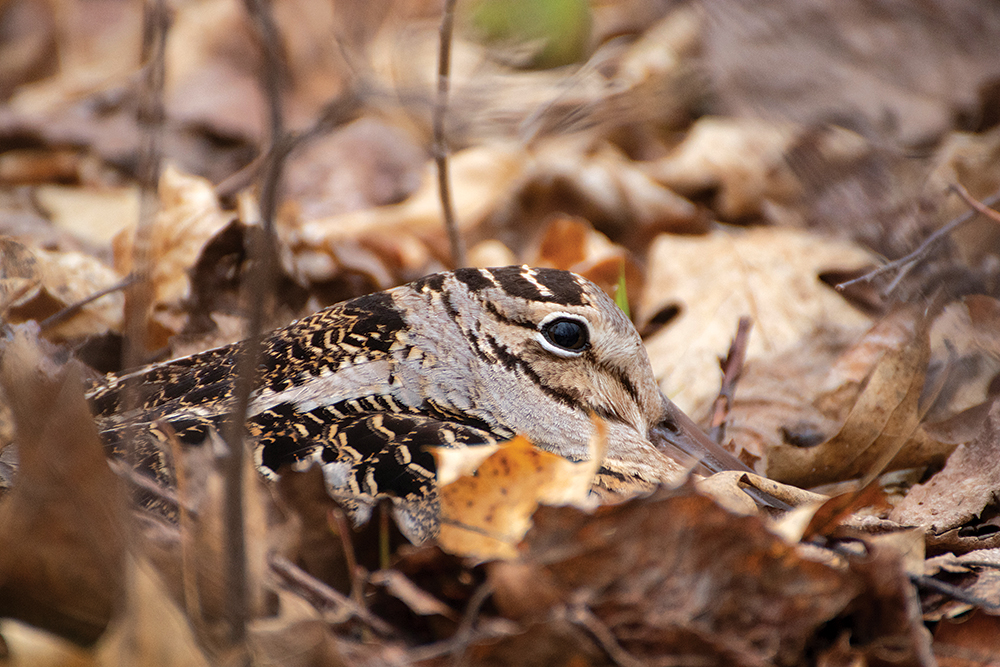Woodcock Worthy

The American woodcock is often overlooked in the upland world when compared to the iconic bobwhite quail, recognizable ring-necked pheasant, or the king ruffed grouse. Especially south of the Mason-Dixon Line, quail reign supreme in the annals of historical literature, highland and lowland habitat efforts, and in the hearts and minds of bird-dog owners who take to the uplands each season. First woodcock references, on the other hand, largely reflect unflattering nicknames—timberdoodle and bogsucker, to name just two—their upside-down brains, questionable flavor on the palate, and the premise that they were formed of leftover parts not used for other birds by the Maker at the beginning of time. However, if you are an upland hunter, dedicated landowner, or passionate conservationist, lend your eyes, ears, sweat, and tears to this worthy gamebird in serious need of future conservation.
The woodcock is a gentleman’s gamebird. The mottled, orange and brown feathers lined with black stripes give them the superpower to remain almost invisible in the young aspens and alders of their Northern nesting regions, or the pines and young forest saplings of their wintering grounds of the Deep South. Coupled with an almost unwavering patience of place afield, the woodcock champions an almost chivalrous intent to hold tight for bird dogs, both pointers and flushers alike. Revered hunting authors, such as Burton Spiller, Gordon MacQuarrie, and George Bird Evans, have marveled over woodcock through the golden years of upland hunting. In The Upland Shooting Life, Evans wrote, “I want there to be woodcock forever flying over in October, and solitude, and Hunter’s Moons.” The woodcock lives in a silent harmony of endurance, charm, and elegance. One of few migratory upland game birds, they fly at night to and from young forest habitats and open fields to feed. When the time comes, some say during the “woodcock moon,” the robin-size birds migrate during evenings from nesting grounds, ranging from Minnesota to Maine, thousands of miles southward to wintering grounds ranging from East Texas to Florida.
Most impressive, the woodcock mating ritual is aptly named the “sky dance.” When ruffed grouse are drumming on stationary logs or wild turkeys gobble and strut aground with fancy tail fans, the woodcock flies a corkscrewing aerial display, precisely at dawn and dusk, with an unmistakable sound known as the “whistling wings” of the uplands. We learned from Aldo Leopold, a forefather of habitat management, of his fondness for the sky dance in A Sand County Almanac, where he penned: “No one would rather hunt woodcock in October than I, but since learning of the sky dance I find myself calling one or two birds enough. I must be sure that, come April, there be no dearth of dancers in the sunset sky.”And despite its obvious grace and grandeur, the woodcock is a generally forgotten species of great conservation need. For the last three decades, woodcock populations are on the steady decline of 1 percent per year, according to the American Woodcock Population Status Reports released by the United States Fish and Wildlife Service (USFWS). The United States Congress requires states to develop a “state wildlife action plan” to guide proactive measures for “species of greatest conservation need” to reduce the need for future listings under the Endangered Species Act. The American woodcock is listed as a species of greatest conservation need in such critical habitat states as Minnesota, Wisconsin, New York, and Maine in the North, and Texas, Louisiana, Arkansas, and Mississippi in the South.
For over five years, I had the pleasure of contributing on the front lines of woodcock conservation in the United States by assisting the Ruffed Grouse Society/American Woodcock Society (RGS/AWS) biology and habitat programs as their editor and director of communications. For over 50 years, RGS/AWS has led the nation in young forest management and advocacy for not only ruffed grouse and woodcock, but numerous other forest wildlife species, and specifically created the American Woodcock Society in 2014 to enhance healthy forest habitat in large areas of the wintering woodcock range. Regionally diverse habitat partnerships and projects are key in the world of upland conservation, which is especially true for woodcock due to their migratory nature. These national conservation efforts must stretch far and wide across the woodcock range, involving federal, state, and local agencies, conservation organizations, and private industries. Federal agencies focused on woodcock conservation and research include the US Forest Service and USFWS, among others. “In addition, just about any state wildlife agency with a woodcock-hunting season is active in woodcock habitat improvement, research, and population monitoring,” said Andrew P. Weik, RGS/AWS regional wildlife biologist. A highlight is the Louisiana Department of Wildlife and Fisheries, which conducts public land management projects, collaborates on outreach efforts with RGS/AWS to conduct habitat management workshops—including one upcoming in 2019; implements numerous woodcock research projects; annually bands more woodcock than any other state; and co-hosted the 2018 Woodcock Wingbee (a special event where wings are submitted by hunters for examination by biologists for sex and age composition, among other data).
“A project with the Forest Service on the Green Mountain National Forest in Vermont will procure timber harvest treatments on about 17,411 acres over a 15-year period,” Weik mentioned as a highlight example of critical work on nesting grounds. “These 5- to 20-acre harvest patches will regenerate into dense sapling escape and feeding cover for grouse, woodcock, neotropical songbirds, and many other forest wildlife species. “In addition to young forest cover, woodcock also use open field-type habitat for night roosting. In the South, these open night-roost habitats are also where woodcock do most of their feeding during the winter months,” Weik continued. “Last winter, the Louisiana Department of Wildlife and Fisheries, with support from RGS/AWS, completed a 250-acre timber harvest to benefit woodcock where some areas will regenerate into saplings for daytime cover, and large portions will be managed for brush hogging and prescribed fire for night roost habitat.”
With woodcock migrating across the nation, stopover habitats in “flyover states” are as critical as those for nesting and wintering. However, researchers previously found difficulty in pinpointing the particular states or areas on which to focus . . . until now. Numerous agency cooperators are outfitting woodcock with satellite transmitters to determine various migration data including timing, rate, distances traveled, routes, and stopover areas. Land managers can now identify priority areas on which to focus future habitat efforts in states not considered nesting or wintering areas, but that are just as crucial to sustain woodcock populations. First implemented by the USFWS, cooperative fish and wildlife research units from Arkansas and Minnesota, and RGS/AWS, among many other partners, this cutting-edge research continues with transmitters placed on birds by numerous other cooperating agencies in numerous regions to diversify the data. Although they’re cryptic and mysterious, don’t forget about the worthy American woodcock in your upland hunting and conservation efforts. Give back to the resource by joining the Ruffed Grouse Society/American Woodcock Society, the nation’s leader in young forest habitat creation and advocacy. Visit them online at ruffedgrousesociety.org. For more information on woodcock hunting, ecology, migration, and habitat, visit youngforest.org and timberdoodle.org.
SHARE ON
You may also like
The role corn plays for gamebirds and economies ac...
Sportsmen’s conservation policy issues from publ...
Sportsmen’s conservation policy issues from publ...


























